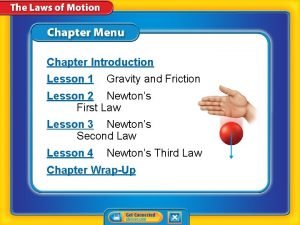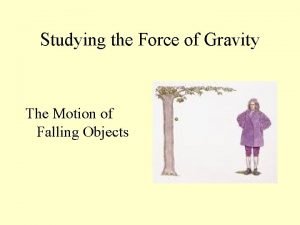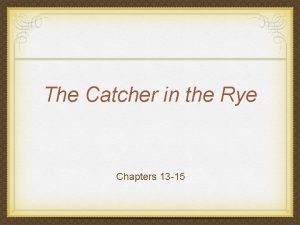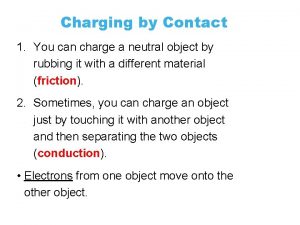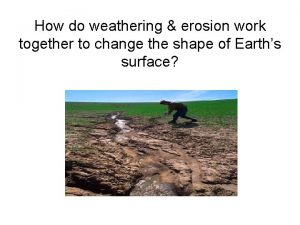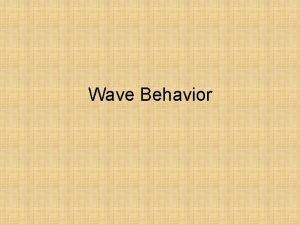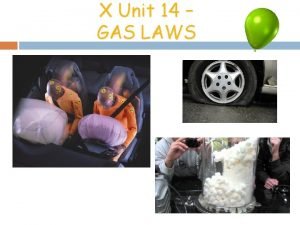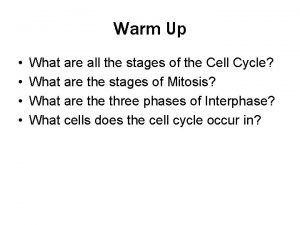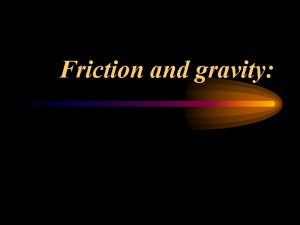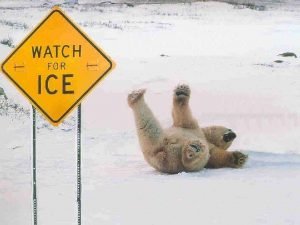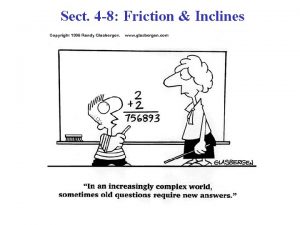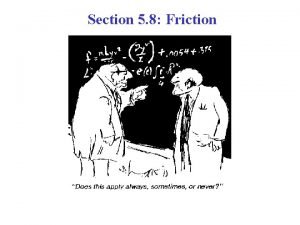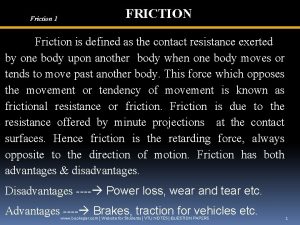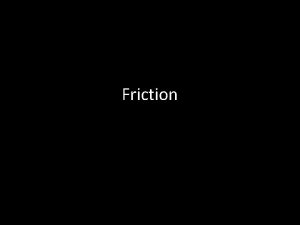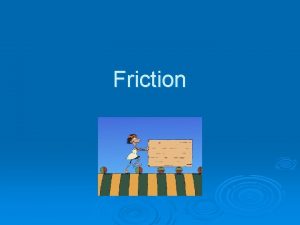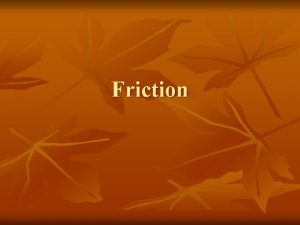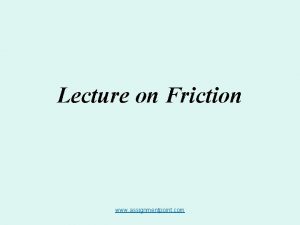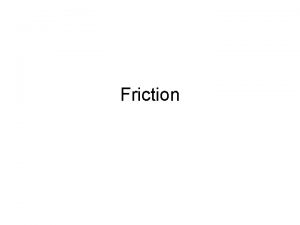Friction and Gravity Friction and Gravity What happens






























- Slides: 30

Friction and Gravity

Friction and Gravity • What happens when you jump on a sled on the side of a snowcovered hill? • What happens at the bottom of the hill? Does the sled keep sliding?

• Why does the sled’s motion change on the side of the hill and then again at the bottom? • Unbalanced forces act on the sled.

• The force of gravity causes the sled to accelerate down the hill. • The force of friction eventually causes the sled to stop.

• The force that two surfaces exert on each other when they rub against each other is called friction.

• In general, a smooth surface produces less friction than rough surfaces. • The strength of the force of friction depends on two factors: • How hard the surfaces push together • The types of surfaces involved

• This water skier gets a fast ride because there is very little friction between her skis and the water.

• Friction also increases if surfaces push hard against each other. • If you rub your hands together forcefully, there is more friction than if you rub them together lightly.

• However, even the smoothest objects will have irregular, bumpy surfaces. • When the irregularities of one surface come in contact with another surface, friction will occur. • Without friction, a moving object might not stop until it hits another object.

Types of Friction • Static • Sliding • Rolling • Fluid

Static Friction • The friction that acts on objects that are not moving. • Because of static friction, you must use extra force to start the motion of stationary objects.

Sliding Friction • This occurs when two solid surfaces slide over each other. • When you go to stop your bicycle with the hand breaks, the rubber pads will slide against the tire surfaces. This will cause the wheels to slow and eventually stop.

Rolling Friction • This takes place when an object rolls across a surface. • This friction is important for engineers who design skates, skateboards, and bikes.

Fluid Friction • This occurs when a solid object moves through a fluid. • This is why the parts of machines that slide over each other are often bathed in oil. • The solid parts move through the fluid instead of sliding against each other.

Gravity • Isaac Newton concluded that a force acts to pull objects straight down toward the center of Earth. • Gravity is the force that pulls objects toward each other.

• He realized that gravity acts everywhere in the universe, not just on Earth. • Apples fall from trees. • Keeps the moon orbiting Earth. • Keeps all the planets in our solar system orbiting around the sun.

• This is called the law of universal gravitation. • Forces of gravity acts between all objects in the universe and attract each other.

• Two factors affect the gravitational attraction between objects: • Mass • Distance

• Mass is the measure of the amount of matter in an object. • SI unit is the kilogram.

• The more mass an object has, the greater its gravitational force.

• The farther apart two objects are, the lesser the gravitational force between them.

• Mass is sometimes confused with weight. • Weight is the measure of gravitational force exerted on an object. • So when you step on the scale, you are determining the gravitational force Earth is exerting on you!

• Weight varies with the strength of the gravitational force but mass doesn’t. • Example: • Astronaut in Spacesuit: • • Weight on moon: 270 N Weight on Earth: 1617 N Mass on moon: 165 kg Mass on Earth: 165 kg

• When the only force acting on an object is gravity, the object is said to be in free fall. • This object will accelerate. • In free fall, the force of gravity is an unbalanced force, which causes the object to accelerate.

• While it may seem hard to believe at first, all objects in free fall accelerate at the same rate regardless of their masses. • Near the surface of Earth, the acceleration due to gravity is 9. 8 m/s 2

• Despite the fact that all objects are supposed to fall at the same rate, you know that this is not always the case. • For example, an oak leaf flutters slowly to the ground, while an acorn drops straight down.

• Objects falling through air experience a type of fluid friction called air resistance. • This is the upward force exerted on a falling object.

• Objects with greater surface area experience more air resistance.

• Air resistance increases with velocity. • As a falling object speeds up, the force of air resistance becomes greater and greater. • Eventually, the falling object will fast enough that the upward force of air resistance becomes equal to the downward force of gravity acting on the object. • They are balanced.

• The greatest velocity a falling object reaches is called terminal velocity. • This is reached when the force of air resistance equals the weight of the object.
 Gravity for dummies and dummies for gravity equations
Gravity for dummies and dummies for gravity equations Gravity and friction
Gravity and friction Gravity and friction lesson 1
Gravity and friction lesson 1 Friction and gravity
Friction and gravity When is friction useful
When is friction useful Why does holden think sunny is spooky
Why does holden think sunny is spooky Romeo juliet
Romeo juliet Romeo and juliet act 4, scene 4
Romeo and juliet act 4, scene 4 Charge by contact
Charge by contact Romeo and juliet act 3 scene 3 summary
Romeo and juliet act 3 scene 3 summary Biogeochemical cycles quiz
Biogeochemical cycles quiz Lotf ch 11 summary
Lotf ch 11 summary Dust bowl 1930s
Dust bowl 1930s Contrast between what is expected and what actually happens
Contrast between what is expected and what actually happens Summary of act 5 in romeo and juliet
Summary of act 5 in romeo and juliet Wacky and uncharacteristic
Wacky and uncharacteristic The purpose of explanation
The purpose of explanation Wave behavior reflection
Wave behavior reflection °c is a unit of what gas property
°c is a unit of what gas property Specific heat of sugar
Specific heat of sugar Where light is hitting an object
Where light is hitting an object What happens in winter
What happens in winter What happens in autum
What happens in autum Brainpop precipitation
Brainpop precipitation What happens in cytokinesis
What happens in cytokinesis Describe what happens during crossing over.
Describe what happens during crossing over. Chapter 27 to kill a mockingbird
Chapter 27 to kill a mockingbird Chapters 22-24 to kill a mockingbird
Chapters 22-24 to kill a mockingbird Tkam chapter 12-16 summary
Tkam chapter 12-16 summary Chapter 23 to kill a mockingbird
Chapter 23 to kill a mockingbird Tewwg chapter 13 summary
Tewwg chapter 13 summary


